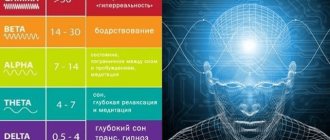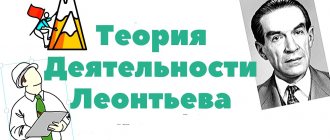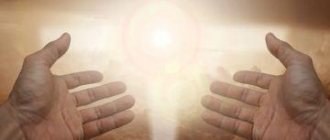When it comes to an altered state of consciousness (ASC), we usually remember specific spiritual practices of esotericists, access to the astral plane, meditation or communication with spirits. All this exoticism and mysticism has nothing to do with the majority of people, and in general is most often fake. However, an altered state of consciousness is a completely common product of our psyche; moreover, everyone has experienced it, although often we do not even pay attention to it. On the other hand, in a number of cases the phenomenon of altered consciousness cannot be called either an ordinary or a natural mental phenomenon, although it still has nothing to do with mysticism. However, let's take it in order.
Altered state of consciousness from a psychological point of view
Since various mystics, psychics and representatives of exoteric esoteric teachings talk a lot about this phenomenon, it is worth turning to the point of view of scientific psychology. But before we talk about an altered state of consciousness, we must first understand what consciousness is in general, that is, normally. And this is not so simple, because there is no clear definition of it, and our consciousness has more secrets and mysteries than objective knowledge about it. Actually, the same can be said about the brain, which produces this consciousness.
Normal consciousness: what is it?
The clear consciousness of a healthy, awake person is manifested in reflecting reality, comprehending it, planning actions and controlling behavior. The main feature of clear consciousness is adequacy, that is, compliance with the reality of which it is a reflection. Images and thoughts that arise in normal consciousness do not contradict reality and allow one to navigate it and interact with the outside world.
For example, if I see a chair standing against the wall, then most likely it is a chair and not an alien monster. Both everyday experience and the logic of thinking tell me this. I can sit on this chair, move it, and it will remain a chair. But if a toad with a rooster’s tail comes out of the boss’s office instead of him, then most likely there is something wrong with my consciousness.
The adequacy of perception and assessment of events, characteristic of clear consciousness, normally coexists with imagination and vivid images of fantasy. After all, this process of creating new images, including those that never existed in reality, is completely conscious, and we perfectly distinguish the products of our invention from real objects. What if we don’t differentiate? Then we are talking about an altered state of consciousness.
What is altered consciousness like?
From a psychological point of view, ASC is a change in mental activity associated with the brain’s adaptation to non-standard (abnormal) external or internal conditions. That is, a change in the environment, including the biochemistry of the brain, causes a reaction in the form of a change in consciousness. This definition may seem strange, because we all exist in a constantly changing world. But this does not mean that every new event leads to changes in our psyche.
ASCs are caused by specific phenomena and circumstances that have a serious impact on the brain. They are characterized by the fact that the usual, standard set of mental reactions does not work under these conditions, and so a failure occurs. Thus, the phenomenon of ASC occurs in a state of passion, when a person is faced with a sudden threat to his life or those close to him. Sudden danger leads to the activation of defense mechanisms and the shutdown of rational thinking, since there is no time to think. A person begins to act and sometimes does almost impossible things: overturns a truck with his hands to save a child, jumps over a four-meter fence, rushes into a raging flame and comes out unharmed, etc. But then he doesn’t remember anything and is unable to explain how he managed do something like this. This is one example of an altered state of consciousness.
Temporary change (stupidity) occurs quite often, and people hardly pay attention to it. For example, short-term inhibition occurs when exposed to different stimuli, when you have to simultaneously respond to different significant stimuli. We can say that our brain “freezes”, unable to immediately and quickly switch from one task to another. A short-term occurrence of ASC occurs in situations of severe fatigue, lack of sleep or severe emotional experiences.
But of particular interest are serious, noticeable to the naked eye, deviations in mental activity, which, nevertheless, do not belong to pathologies. The manifestations of such altered states of consciousness are very diverse, as are the reasons that give rise to them. But there are also general signs by which we can determine the occurrence of ASC in a person.
- Subjectivity of experiences when other people do not see or feel the same as an individual with ASC (hallucinations, visions, illusions).
- The inadequacy of the images of consciousness, that is, the discrepancy between their reality.
- As a consequence of this, inappropriate behavior, since reactions to subjective reality do not correspond to objective reality. For example, mistaking a large stone for a monster, a person runs away from it in horror. Or he drives away the devils he sees in a state of alcoholic delirium (delirium tremens).
- Uncritical assessment of one's judgments and behavior - a person in a state of distorted consciousness accepts his visions as reality and does not feel any contradiction with common sense.
The simplest and, I think, well-known example of deviant behavior in ASC is alcohol intoxication. It is a consequence of the brain’s reaction to ethyl alcohol poisoning. This manifests itself in a decrease in the activity of the frontal lobes of the brain, which are responsible for rational control.
Depending on the reasons causing the altered state of consciousness, there are 3 types of this phenomenon:
- ASC that arises spontaneously, that is, naturally.
- Conditions caused by psychotropic drugs.
- Changes in consciousness as a result of the use of various psychotechniques.
Despite the various factors that give rise to ASC, these conditions have much in common, but there are also very significant differences, including in terms of consequences. Therefore, it is worthwhile to dwell on each type in more detail.
How to choose a device?
Different degrees of ASC require different devices. Among the most well-known on the market, we can recall several modified generations of the Novodimmer device, electrosleep devices or xenon inhalation devices. But how to choose from all this? After all, sometimes the described effects are not always necessary or even achieved in reality. For example, the same mentioned “Novodrimmer” appears in the description as an audiovisual drug, while its undoubted advantages in therapy are somewhat less covered.
How do you generally understand what to try and what devices are suitable? What is their power of influence and what will it be necessary for certain studies? Denis Burkhaev devoted an entire webinar “Hardware Methods of ISS” to this topic. So, before purchasing any device, it is certainly worthwhile to thoroughly familiarize yourself with its instructions, the results of practical work on it, and the experience of practicing psychotherapists. Besides, it's worth trying. Where is this opportunity? First of all, in sleep medicine clinics, and secondly, in special psychotherapeutic clinics.
As for the disadvantages of the devices, it is most likely high cost. After all, almost all of them are certified as medical. But, let us remind you once again that such devices are legal in our country, they allow you to control the ISS process and achieve the results that are included in your plans.
Altered states of consciousness caused by natural causes
The most natural and normal of this group is sleep.
Sleep as a form of altered consciousness
Yes, yes, this is also an altered state of consciousness. True, for a long time it was not considered such, but was viewed as simply rest, during which both the brain and the entire body are passive. And dreams were considered akin to memories or fantasies.
But serious scientific research has proven that sleep is not associated with loss of activity; during it, our body functions and the brain is quite active. We do not lose consciousness, it simply changes, creating illusory images from pieces of real events, persons, and objects that a person has in his memory.
This means that sleep is an altered state of consciousness, although it differs from other similar phenomena. But it can also be considered a reaction to changes in the biochemical environment of the brain. In response to fatigue or the rhythm of sleep and wakefulness that has been formed over the years, a special protein compound is produced in the neurons of the brain - melatonin, which is also called the sleep hormone. All higher mental functions are inhibited, the activity of the neocortex (the upper part of the cerebral cortex) decreases, and images of the subconscious, penetrating from the depths of the psyche, change the content of our consciousness. The mechanism of sleep is much more complex, but I will not dwell on it in detail here.
Painful states of altered consciousness
Sleep is a normal and even necessary state of our body. But in extreme situations, when the nervous system experiences severe stress, overload or, for example, exposure to high temperature, various forms of ASC can also occur.
- Delirium is a painful condition in which a person talks a lot and incoherently, talks about strange things or talks with absent people and is not aware of it. Often he does not even respond to comments or questions from the real world.
- Hallucinations are visions, images generated by a painful state of the body or extreme environmental conditions. Thus, hallucinations can occur in a state of sensory deprivation, that is, in a person deprived of the usual channels of perception, for example, locked in a cramped dark space in absolute silence.
- A stunned state of consciousness that occurs due to serious illness, poisoning and traumatic brain injury. This ASC manifests itself as lethargy, delayed reaction, poor spatial orientation, or indifference to everything.
With mental illnesses, there is also a change in consciousness and sometimes quite severe mental deviations. But they do not belong to ASC, since this phenomenon concerns only mentally normal people.
Completion
And that’s all for today, dear readers! Choose the most suitable method for yourself and start implementing it. Just take care of your own safety. As you can understand, the AIS process does not always go “smoothly”.
Good luck to you on your path to a new life!
We also recommend that you read an article about human superpowers and the ability to realize them.
The material was prepared by psychologist, Gestalt therapist, Alina Zhuravina
Read further:
Methods and practices for expanding consciousness
What is mass consciousness and the main methods of modern manipulation
TOP 12 films to change your thinking about the meaning of life
Suspiciousness: causes and ways to get rid of this condition
Basic ways and methods for changing the qualities of your character for the better
6
ASC arising under the influence of psychotropic drugs
The term “psychotropic drugs” is understood very broadly. These are a variety of plant and chemical substances that cause an altered state of consciousness. Since ancient times, they have been used in various mysteries, religious cults, practices of esoteric teachings, rituals of priests and shamans. The Vikings, for example, drank a decoction of fly agarics to achieve warlike exaltation and insensitivity to pain. The Scythians and ancient Greek priests used hemp, and the Incas used coca leaves. The sorcerers of Western Europe used henbane and dope in their rituals, and in Southeast Asia they used opium.
These substances caused a state of excitement and vivid hallucinations or, on the contrary, calmed the person and put the person into a trance state. They were used occasionally, on special occasions, so they were not addictive and did not become drugs. They became them when they began to be used for profit.
In the 20th century, the list of psychotropic substances expanded significantly due to new chemical compounds developed in special laboratories. But the purpose of these substances is the same - to achieve a state of altered consciousness. In addition to the purpose, various psychologically active substances share a common mechanism of action. They affect the composition and shape of very important brain structures - neurotransmitters or neurotransmitters. These protein compounds ensure normal communication between nerve cells. Changes in them cause deviations in mental activity, which are accompanied by an aggravation of all senses and a feeling of euphoria. True, the consequences of this are also no less striking: the inevitable “rollback” and exhaustion of the nervous system lead to depression, and the systematic use of psychotropic substances leads to addiction, which is associated with changes in the biochemistry of the brain.
The altered state of consciousness is also called psychedelic. Although this name comes from two ancient Greek words – “soul” and “clear”, it is difficult to call this state clear. True, subjectively, a drug trance is most often perceived as a feeling of insight. It is enough to cite the experiment of the eccentric American physicist R. Wood as an example. He, having smoked opium, in a state of narcotic trance, wrote down, as it seemed to him, a brilliant scientific idea. When he woke up, he read the note he had made about the discovery, which read: “The banana is big, but its peel is even bigger.” That's all the "epiphany" is.
By the way, psychotropic substances include not only drugs, but also alcohol, nicotine and even coffee. It's all about the quantity of their use.
Kinkhin
Kinhin or walking meditation is practiced in Zen schools between long sessions of sitting meditation. Kinkhin can also be practiced as a separate independent exercise for those who find it difficult to sit in a motionless position.
Depending on the school, the walking speed in kinhin may vary. Sometimes they take half a step in one breathing cycle, sometimes 10 steps. But the essence of walking meditation is the same: maximum conscious movements and full concentration of attention on breathing and the process of walking.
Stand straight, feet shoulder-width apart, weight distributed evenly. Relax your body to such an extent that there is no unnecessary tension, but at the same time be in a stable position. Place your palms at chest level. Imagine that you are being pulled up by a rope tied to the top of your head. This will help straighten your back and neck. Direct your gaze to the ground two meters away from you, without focusing on anything in particular. Relax your shoulders, arms, face. Start walking very slowly, one step per breath.
Focus all your attention on breathing and body movement. Just like in sitting meditation, allow your thoughts to flow freely, but keep most of your attention on your breathing.
When you are ready to end your practice, stop slowly, look up, and walk at a normal pace for a couple of minutes.
Sensory deprivation chambers
A small example from popular culture: in the first season of the series Stranger Things, there was a moment when Eleven’s pool was filled with water, a large amount of salt was poured into it, and then a “helmet” was put on the girl, and after that she wandered through the palaces of the mind.
It was a homemade sensory deprivation chamber. Today, such procedures, also called “floating,” can be performed in special institutions equipped with such capsules, or in yoga centers. This camera was invented in the 50s by Dr. John Lilly. At that time, he was studying the human brain, or rather, trying to understand where it gets its energy from. Lilly tried to create conditions of complete isolation in order to make observations of the behavior of the brain - such a camera became the best option for his experiments. What is a modern sensory deprivation chamber like? In general terms, this is a container of water at room temperature into which a person is immersed. The water has a very high salt content so that the body can float calmly on its surface - this creates a feeling of weightlessness. The chamber is protected from light and soundproofed. It turns out that you are immersed in complete darkness and “floating” there, when even tactile sensations are dulled, and you only hear your own breathing and how your stomach growls if you forgot to have a snack.
Some compare it to the womb, others talk about space. And where can we expect altered states? After all, I don’t experience hallucinations while lying on the couch after work. It's again about the poor brain, for whom extreme situations are created. Your senses cannot read the information, and your brain, like a blind gunner, begins to fire projectiles in different directions, hoping to at least clarify something. Just as a bat receives information about the world around it by shooting ultrasonic waves, your skull buddy tries to understand what is happening by releasing uncontrollable images. But mostly it will be a way of relaxation for you after a hard day. Because here you lie and really do NOTHING.
Not everyone reaches the state of a sick dreamer, but a couple of crazy ideas or pictures may pop up in your head. At least this method is relatively safe for the body. It might just cause a panic attack if you're claustrophobic or can't swim. Oh yes, don’t try to scratch your eyes while you’re lying in this capsule—salty water will be perceived negatively by your retina. Also, various fresh scratches or wounds can remind you when you find yourself in the water.









